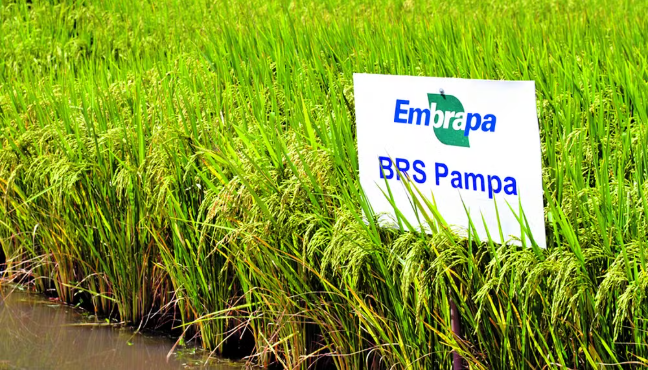Tags
Rice is more sustainable and productivity doubles in Brazil’s South
90% of the crop’s emissions occur in irrigated soils.
By Lauro Veiga Filho

Mitigating methane emissions from irrigated rice fields requires a combination of techniques that have been advancing in the Brazilian southern states of Rio Grande do Sul and Santa Catarina, which account for almost 79% of Brazil’s rice production. “There are several strategies that we can combine in search of solutions that do not put the producer at risk of productivity loss,” explains researcher Walkyria Scivittaro, from Embrapa’s temperate climate arm, referring specifically to farms in Rio Grande do Sul.
According to her, 90% of emissions from rice production occur in irrigated soils, caused by the action of microorganisms decomposing organic matter. Mitigation practices seek to minimize this process. “The main strategy has been to prevent the soil from being flooded for longer than desirable, by reducing the irrigation period or decreasing the water depth,” points out Ms. Scivittaro. These solutions need to be finely balanced because irrigation, which occurs in Rio Grande do Sul under a continuous flooding regime, predominantly in lowland areas, brings benefits, helping in the physical control of weeds and pests, in addition to favoring the productive potential of the crop.
The adoption of irrigation systems using “ridge furrows” or sprinklers, she adds, has emerged as an alternative, but there are other options, such as the use of early soil preparation, a practice adopted by 60% to 70% of rice farmers in Rio Grande do Sul. In this case, the producer drains the water immediately after harvesting and incorporates all the remaining organic matter in the autumn, a drier period, taking full advantage of the ideal planting window in the following spring.
In general, considering more generic data, Ms. Scivittaro notes that sprinkler irrigation can mitigate up to 95% of emissions, but this practice requires flatter areas and does not apply to all growing regions. Furrow irrigation and early soil preparation techniques can bring gains between 25% and 30%. Rotational planting of rice, soybeans, or corn, she adds, would allow for mitigating one-fifth of emissions.
Embrapa has also been working for seven years on the research and development of rice varieties that combine good productivity, health, grain quality, and low emission potential. “Seeds with higher productive potential generally emit fewer greenhouse gases,” notes Ms. Scivittaro.
Launched in January by the Rio Grande do Sul Rice Institute (IRGA), the RS14 Rice System project aims to develop, together with producers, ways to increase the productivity of rice farming in the state to 14,000 kg/hectare, focusing on good cultural practices and sustainable management, says Luiz Fernando Siqueira, manager of IRGA’s Technical Assistance and Rural Extension Division (Dater). If the goal is achieved, productivity could grow by almost 55%, considering the average harvest of 9,044 kg/hectare in Rio Grande do Sul during the 2024/25 season. “The abbreviation RS refers to resilience and sustainability,” says Mr. Siqueira, citing the acronym for the state of Rio Grande do Sul.
The project combines the rotational planting of rice, soybeans, and corn in the summer crop season with forage crops in the winter, when traditionally the farmland areas are left empty, which can also be associated with livestock farming. Currently, according to Mr. Siqueira, three dozen areas participate in the project, generating data and information that will be compiled and systematized in order to contribute to management improvement, which should be translated into a reduction in emissions, especially of methane.
The project consolidates almost a decade of studies on sustainable production systems developed by the IRGA’s research station in Uruguaiana, Rio Grande do Sul. Last year, Mr. Siqueira points out, IRGA’s extension team underwent intensive training, following the implementation protocols defined for the new project, which also provides for no-till farming and early irrigation at the emergence stage of the first leaf of the rice plants, which favors their development.
One of the properties that has already adopted a similar management format for ten harvests, located in the central region of the state, managed to more than double its productivity, going from 5,900 kg/hectare in the 2013/14 season to 12,685 kg/hectare on average over the last five harvests, according to Mr. Siqueira. Gains were even more significant when considering the average productivity of the last two harvests, at 13,685 kg/hectare.
Starting in the 1990s, the researcher recalls, rice producers in Rio Grande do Sul began adopting minimum tillage practices, which reduce soil disturbance, also generating fewer emissions. Estimates suggest that 70% of the nearly 9,000 producers in the state adopt this practice.
The use of early straw management, as is the case in Rio Grande do Sul, and changes in irrigation management of rice fields in Santa Catarina have contributed to mitigating emissions, and research, among other efforts, has focused on developing systems to measure the mitigating impacts associated with conservation practices. The idea is to create a model for measuring, verifying, and reporting the volumes of mitigated emissions in order to allow producers to access preferential credit lines under the ABC Plan, and in the future participate in the carbon credit market and programs aimed at remunerating environmental services, explains Marcos do Vale, a researcher at the Agricultural Research and Rural Extension Company of Santa Catarina (EPAGRI).
Among other practices, Mr. Vale highlights the early management of straw, using a roller-crimper, which allows for “crushing and flattening” crop residues, incorporating them into the soil immediately after harvesting. Two years ago, the state government began subsidizing half the cost of the implement for producers, which has allowed the number of farmers adopting the practice to increase to 70% throughout the state, out of a total of 5,000 families dedicated to rice cultivation.
https://valorinternational.globo.com/climate-emergence-special-supplement/news/2025/11/12/rice-is-more-sustainable-and-productivity-doubles-in-brazils-south.ghtmlPublished Date: November 13, 2025






